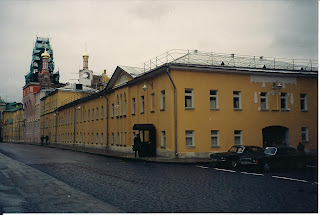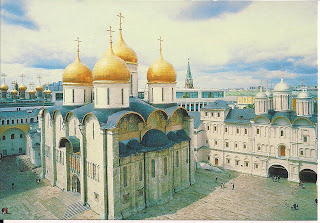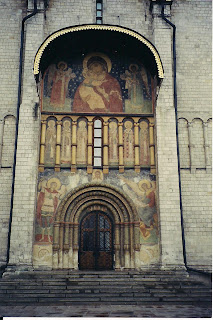It is surrounded by a park, a green space full of trees, benches and walkways. I had just spent a very cold time travelling through Russia, and coming to Poland was like passing from winter into spring. There was green and sunshine everywhere. Very nice.
The park follows where the walls of the city used to stand. There are some remnants still standing, including some of the gates. The most impressive of these is called the "Barbican." It was covered with scaffolding while I was there, so I couldn't get a real good look at it.
If you have ever seen a movie set in Europe, you may have a general idea of the architecture presented on the streets.
Very old, interesting looking buildings, cobbled streets, and plazas where people gather.
There are also a few churches here and there. I find it hard to express in words just how marvellous these buildings are.
There is one close to the Wawel, that has statues of saints and the apostles carved on the front. These churches and cathedrals are impressive just from the outside, but it is their interiors that really take your breath away. Everywhere you look, there is something to awe and inspire you. After a while, it gets to be too much, but is you manage to visit each place with a fresh outlook, you can see art, statuary, stained glass, all dedicated to the worship and praise of God. For me, a person used to a fairly Spartan house of worship, it is like going from the cover of the "White Album" to the cover of "Sgt. Pepper."
In the centre of the town is the main square, called the "Rynek Glowny." This is the largest city square in Europe.
At the southwest corner stands a clock tower.
Cloth Hall (left) and the Basilica (centre)
In the middle is the "Cloth Hall," which is now basically a mall. A mall that has been in business for approximately 700 years. At the northwest corner stands the Basilica of the Virgin Mary. It was from this tower, in 1400, that a guard blew his trumpet to warn of an attacking army. He was killed in the ensuing battle, but the town was saved. A trumpet is blown every hour on the hour in his memory.
There are many beer gardesns on the square (Mmmmmmmmmmmmmm beer), and it is very pleasant to sit in the sun, drink beer, and watch the activity going on around. There are horse drawn carriages taking tourists for a tour, as well as golf carts accomplishing the same task for those afraid of horses.
Krakow has wells situated around the city, with pumps that anyone can use to take as much water as they can carry. It was near one of these pumps in the town square that a young man, protesting against the communist government of the time, immolated himself. There is a plaque commemorating his deed. To the west of the centre of town, a large, man-made hill rises. it is called the "Kopiec Kosciuski." it was built in memory of a man called Thomas Kosciuski, who fought in the American Revolutionary war, and then returned to Poland to fight for its independence.
Shortly after the mound was raised, a fort was built around it. It's now a hotel, but you can see a beautiful chapel and climb to the top of the mound for a view of the city.
In the centre of the hotel is a plaza named for Paul McCartney. Who knows what he did to earn that honour.
In my next instalment, we'll visit the former Jewish ghetto, Schindler's factory, and Plaszow.
.jpg)
.jpg)
.jpg)
.jpg)
.jpg)

.jpg)
.jpg)
.jpg)

.jpg)
.jpg)
.jpg)
.jpg)
.jpg)
.jpg)
.jpg)
.jpg)
.jpg)
.jpg)
.jpg)
.jpg)
























